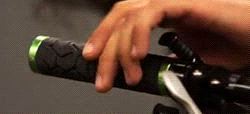Inkjet & Digital Printing
Trek Bikes Race for Peak Performance with Color, Multi-material 3D Printing

Friday 07. March 2014 - Trek Bicycle, a worldwide leader in the design and production of top-quality performance bicycles, integrated 3D printing into its design process several years ago.
Trek’s bicycle frames are world-famous, but also developed in-house are other bike essentials and accessories marketed under the brand name Bontrager. Bontrager products include such items as handlebars, tires, wheel rims, seat posts and saddles (seats).
Relying on a new Objet500 Connex3 Color Multi-material 3D Printer by Stratasys, members of the design team at Trek headquarters in Waterloo, Wisconsin, have used 3D printing since 2008 as a way both to slash their prototyping time and to make rapid changes after functional testing of prototyped parts. Using sturdy PolyJet Digital ABS material for a wide variety of parts – on its own or combined with rubber-like Tango material in a single print run – the prototyped parts can be reviewed by among many departments at Trek and even venture out to be seen and touched at trade shows.
Because of the prototyping team’s familiarity with Connex multi-material 3D printing technology, Trek was selected to preview the newly launched Objet500 Connex3 Color Multi-material 3D Printer by Stratasys. Trek’s beta testing was reviewed and team members gave their impressions of it at the Objet500 Connex3 launch in January 2014 at SolidWorks World in San Diego.
Patrick Zeigle, Engineering Tech on the Trek prototyping team, spoke about the advantages of a rapid design cycle by relating a new handlebar design: “The design will have multiple iterations 3D printed on our Objet500 Connex3, whether it’s just small design changes, structural changes, or aerodynamic changes that will be tested in the wind tunnel.”
The prototype shop at Trek made the most of their Objet500 Connex3 preview. Among the colorful, multi-material items they printed were:
lightweight, aerodynamic bike helmets in a rainbow of colors;
multi-colored bike saddles that display pressure mapping;
saddle posture display pieces (partial skeletons that “sit” on bike seats to demonstrate fit);
handlebar grips that were field-tested the same day they were 3D printed;
and a multi-material chain protector.
Guadalupe Ollarzabal, Engineering Tech in Trek’s prototype shop, was excited about color from the Objet500 Connex3. “It’s going to help out our paint and graphics team,” he noted. “We wouldn’t have to print in white and then waste precious time wrapping a red logo.”
Chain protector & sound guard produced using Digital ABS and rubber-like TangoBlackPlus material
Patrick Zeigle described a piece that insulates the chain from unnecessary wear, prototyped with both Digital ABS and rubber-like Tango materials in a single print run: “With the Objet500 Connex3 we were able to make a part that snaps around the chainstay, has a hard inner so it stays in place, and then a soft outer that takes up all the sound from the chain.”
The overall efficiency of the prototyping shop has improved with the addition of the Objet500 Connex3 Color Multi-material 3D Printer to the stable of machines found at Trek headquarters. The machinist-engineers are thrilled to be able to pass on absolutely the best-designed, best-engineered bike parts to both cycling professionals and devoted amateur enthusiasts.
Functional handlebar grip prototype produced using rubber-like TangoBlackPlus material on the Objet500 Connex3
“The bikes we make here at Trek are made of multiple materials. We make parts that have different densities, different colors, and the new Objet500 Connex3 takes care of both of them,” explained Mike Zeigle, the prototype development group’s manager. “The Objet500 Connex3 is the best tool for the job.”
Watch the exciting video case study to see how Trek is using Objet500 Connex3 for color multi-material 3D printing for functional parts testing and accelerated design cycles.
